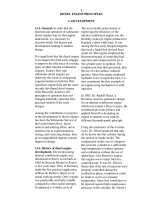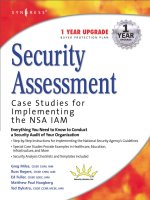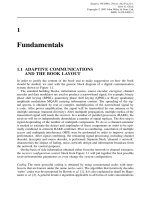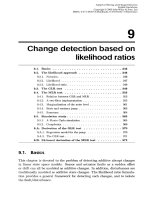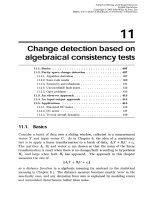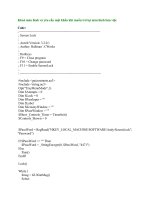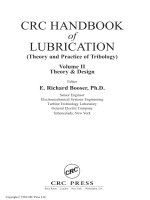Tài liệu Adaptive WCDMA (P1) docx
Bạn đang xem bản rút gọn của tài liệu. Xem và tải ngay bản đầy đủ của tài liệu tại đây (265.87 KB, 22 trang )
1
Fundamentals
1.1 ADAPTIVE COMMUNICATIONS
AND THE BOOK LAYOUT
In order to justify the content of the book and to make suggestions on how the book
should be studied, we start with the generic block diagram of a digital communication
system shown in Figure 1.1.
The standard building blocks, information source, source encoder, encryptor, channel
encoder and data modulator are used to produce a narrowband signal, for example, binary
phase shift keying (BPSK), quaternary phase shift keying (QPSK) or M-ary quadrature
amplitude modulation MQAM carrying information content. The spreading of the sig-
nal spectra is obtained by real or complex multiplication of the narrowband signal by
a code. After power amplification, the signal will be transmitted by one antenna or by
multiple antennae (transmit diversity). After multipath propagation, multiple replica of the
transmitted signal will reach the receiver. In a number of parallel processors (RAKE), the
receiver will try to independently demodulate a number of signal replicas. The first step is
signal despreading of the number of multipath components. To do so a channel estimator
is needed to estimate the delays and amplitudes of these components in order to be opti-
mally combined in coherent RAKE combiner. Prior to combining, cancelation of multiple
access and multipath interference (MPI) may be performed in order to improve system
performance. After signal combining, the remaining signal processing, including channel
decoder, decryptor and source decoder, is performed. Separate block ‘channel+ network’
characterizes the impact of fading, noise, network design and information broadcast from
the network for control purposes.
On the basis of side information obtained either from the network or channel estimator,
the receiver configuration control block from Figure 1.1 will put together the best possible
receiver/transmitter parameters or even change the system configuration.
Coding The most powerful coding is obtained by using concatenated codes with inter-
leavers that are known under the name turbo codes. The algorithm that iteratively decodes
‘turbo’ codes was first proposed by Berrou et al. [1]. It is also explained in detail by Hage-
nauer et al. [2]. A general iterative algorithm applicable to all forms of code concatenations
Adaptive WCDMA: Theory And Practice.
Savo G. Glisic
Copyright
¶
2003 John Wiley & Sons, Ltd.
ISBN: 0-470-84825-1
2
FUNDAMENTALS
Receive diversity
Discrete memoryless source
Spreading code
generator
Channel &
network
Channel
estimation
Source
encoder
{1,2,…,
q
}
Information
source
Higher layers
Information
sink
Source
decoder
Decryptor
Channel
decoder
Data
demodulator
MU MLSE
Spread
spectrum
despreader
Receiver
front
end
Transceiver configuration
control
Encryptor
Channel
encoder
Data
modulator
Spread
spectrum
modulator
Power
amplification
(power
limitation)
Transmit diversity
(multiple access)
Figure 1.1 Generic block diagram of a digital communication system.
has been described by Benedetto et al. [3]. A number of papers have appeared on the subject
of the ‘turbo’ iterative decoding algorithms, showing that it can be viewed as an instance
of previously proposed algorithms (see, for example, Reference [4] and the extensive ref-
erences therein). To avoid a huge reference list, the readers are referred to the papers and
references in the European Transactions on Telecommunications [5], and in the IEEE Jour-
nal on Selected Areas in Communications [6], entirely devoted to concatenated codes and
iterative decoding.
Coded modulation It has been generally accepted that modulation and coding should be
combined in a single entity for improved performance. Of late, the increasing interest
in mobile radio channels has led to the consideration of coded modulation for fading
channels. Thus, at first blush it seemed quite natural to apply ‘Ungerboeck’s paradigm’ of
keeping coding combined with modulation even in the Rayleigh fading channel, in which
the code performance depends strongly on the code minimum Hamming distance (the
‘code diversity’), rather than on its minimum Euclidean distance. Several results followed
this line of thought, as documented by a considerable body of work summarized and
referenced in Reference [7] (see also Reference [8], Chapter 10). Under the assumption
that the symbols were interleaved with a depth exceeding the coherence time of the fading
process, new codes were designed for the fading channel so as to maximize their diversity.
A notable departure from Ungerboeck’s paradigm was the core of Reference [9].
Schemes were designed aimed at keeping as their basic engine an off-the-shelf Viterbi
ADAPTIVE COMMUNICATIONS AND THE BOOK LAYOUT
3
decoder for the de facto standard, 64-state rate-1/2 convolutional code. This implied giving
up the joint decoder/demodulator in favor of two separate entities.
On the basis of the latter concept, Zehavi [10] recognized that the code diversity, and
hence the reliability of coded modulation over a Rayleigh fading channel, could be further
improved. Zehavi’s idea was to make the code diversity equal to the smallest number of
distinct bits (rather than channel symbols) along any error event. This is achieved by
bit-wise interleaving at the encoder output, and by using an appropriate soft-decision bit
metric as an input to the Viterbi decoder. Further results along this line were recently
reported in References [11–13] (for different approaches to the problem of designing
coded modulation schemes for the fading channels, see References [14,15]).
Of particular interest is paper [16] based on Zehavi’s findings, and in particular
on his rather surprising apriori result that on some channels there is a downside
to combining demodulation and decoding. The paper presents the theory underlying
bit-interleaved coded modulation (BICM) comprehensively, and provides a general
information-theoretical framework for this concept.
It also provides results for a large range of the signal constellation QPSK-256 QAM.
Adaptive coded modulation After the signal despreading point in Figure 1.1, we assume
a flat-fading channel with additive white Gaussian noise (AWGN) n(t) and a stationary
and ergodic channel gain
√
[g(t)]. Let
S denote the average transmit signal power, N
0
/2
denotes the noise density of n(t), B denotes the received signal bandwidth, and
g denotes
the average channel gain. With appropriate scaling of
S, we can assume that g = 1. For
a constant transmit power
S, the instantaneous received signal-to-noise ratio (SNR) is
γ(t)=
Sg(t)/(N
0
B) and the average received SNR is γ = S/(N
0
B). We denote the
fading distribution of γ by p(γ ). If the transmit power S(t) is adapted relative to g(t)
or, equivalently, to γ(t), then the SNR at time t is given by
SNR(t) =
γ(t)S[γ(t)]
S
=
g(t)S[g(t)]
N
0
B
In accordance with Reference [17], adaptive coded modulation does not require inter-
leaving, since error bursts are eliminated by adjusting the power, size and duration of
the transmitted signal constellation, relative to the channel fading. In general, we would
rather like to include the interleaver in the block ‘channel encoder’ in Figure 1.1. For
fast fading, in which adaptation is less effective, the interleaving should help. For slow
fading, in which adaptation is more effective, the interleaver cannot do much but neither
does it do any damage.
However, adaptive modulation does require accurate channel estimates at the receiver,
which are fed back to the transmitter with minimal latency. The effects of estimation
error and feedback path delay on adaptive modulation were analyzed in Reference [18],
in which it was found that an estimation error less than 1 dB and a feedback path delay
less than 0.001/f
D
results in minimal performance degradation, for f
D
= v/λ the Doppler
frequency of the fading channel. The effect of estimation error and feedback path delay for
adaptive coded modulation is similar, yielding the same set of requirements for minimal
performance degradation. These requirements are easily met on slowly varying channels.
4
FUNDAMENTALS
Another practical consideration in adaptive coded modulation scheme is how quickly
the transmitter must change its constellation size. Since the constellation size is adapted
to an estimate of the channel fade level, several symbol times may be required to obtain
a good estimate. In addition, hardware and pulse-shaping considerations generally dic-
tate that the constellation size must remain constant over tens to hundreds of symbols.
It was shown in Reference [18] that this requirement translates mathematically to the
requirement that
τ
j
T ∀j ,whereT is the symbol for time and τ
j
is the average time
when the adaptive modulation scheme continuously uses the constellation M
j
. Since each
constellation M
j
is associated with a range of fading values called the fading region
R
j
, τ
j
is the average time that the fading stays within the region R
j
. The value of
τ
j
is inversely proportional to the channel Doppler and also depends on the number
and characteristics of the different fade regions. It was shown in Reference [18] that in
Rayleigh fading with an average SNR of 20 dB and a channel Doppler of 100 Hz,
τ
j
ranges between 0.7 and 3.9 ms, and thus for a symbol rate of 100 ksymbols s
−1
, the sig-
nal constellation remains constant over tens to hundreds of symbols. Similar results hold
at other SNR values.
In a narrowband system, the flat-fading assumption in this model implies that the signal
bandwidth B is much less than the channel coherence bandwidth B
c
= 1/T
M
,whereT
M
is the root-mean-square (rms) delay spread of the channel. For Nyquist pulses B = 1/T ,
so flat fading occurs when T T
M
. Combining T T
M
and τ
j
T , we see that τ
j
T T
M
must be satisfied to have both flat fading and the signal constellation constant
over a large number of symbols. In general, wireless channels have rms delay spreads less
than 30 µs in outdoor urban areas and less than around 1 µs in indoor environments [19].
Taking the minimum
τ
j
= 0.7 ms, we see that on the basis of the previous relation, rates
on the order of tens of ksymbols per second in outdoor channels and hundreds of ksymbols
per second in indoor channels are practical for this adaptive scheme.
For WCDMA, these conditions will be extensively discussed throughout the book,
especially later on in this chapter and then in much more detail in Chapter 8.
Coset codes with adaptive modulation Reference [17] shows how the separability of code
and modulation design inherent in coset codes can be used to combine coset codes with
adaptive modulation. A binary encoder E, from Figure 1.1, operates on k uncoded data
bits to produce k + r coded bits, and then the coset (subset) selector uses these coded
bits to choose one of the 2
k+r
cosets from a partition of the signal constellation. In
nonadaptive modulation dealt with in Reference [20], the modulation segment uses n − k
additional uncoded bits to choose one of the 2
n−k
signal points in the selected coset,
which is then transmitted via the modulator. These steps essentially decouple the channel
coding from the modulation. Specifically, the fundamental coding gain is a function of
the minimum squared distance between signal point sequences, which is determined by
the encoder (E) properties and the subset partitioning, independent of the modulation.
This minimum distance is given by d
min
= min{d
s
,d
c
},whered
s
is the minimum distance
between coset sequences and d
c
is the minimum distance between coset points. For square
MQAM signal constellations, both d
s
and d
c
are proportional to d
0
, the minimum distance
between constellation points before partitioning. The number of nearest neighbor code
words also impacts the effective coding gain.
ADAPTIVE COMMUNICATIONS AND THE BOOK LAYOUT
5
In a fading channel, the instantaneous SNR varies with time, which will cause the
distance d
0
(t) in the received signal constellation, and, therefore, the corresponding
distances d
c
(t) and d
s
(t), to vary. The basic premise for using adaptive modulation
with coset codes is to keep these distances constant by varying the size M(γ),trans-
mit power S(γ ), and/or symbol time T(γ) of the transmitted signal constellation rel-
ative to γ , subject to an average transmit power constraint
S on S(γ ). By maintaining
min{d
c
(t), d
s
(t)}=d
min
constant, the adaptive coded modulation exhibits the same coding
gain as a coded modulation designed for an AWGN channel with minimum code word
distance d
min
.
The modulation segment on Figure 1.1 would work as follows. The channel is assumed
to be slowly fading so that γ(t) is relatively constant over many symbol periods. During
a given symbol period T(γ), the size of each coset is limited to 2
n(γ )−k
,wheren(γ )
and T(γ) are functions of the channel SNR γ . A signal point in the selected coset is
chosen using n(γ ) − k uncoded data bits. The selected point in the selected coset is one
of M(γ)= 2
n(γ )+r
points in the transmit signal constellation [e.g. MQAM, M-ary phase-
shift keying (MPSK)]. By using appropriate functions for M(γ), S(γ) and T(γ),we
can maintain a fixed distance between points in the received signal constellation M(γ)
corresponding to the desired minimum distance d
min
. The variation of M(γ) relative to
γ causes the information rate to vary, so the uncoded bits used for signal point selection
must be buffered until needed. Since r redundant bits are used for the channel coding,
log
2
M(γ)− r bits are sent over the symbol period T(γ) for a received SNR of γ .The
average rate of the adaptive scheme is thus given by
R =
∞
γ
0
1
T(γ)
[log
2
M(γ)− r]p(γ ) dγ
where γ
0
≥ 0 is a cutoff fade depth below which transmission is suspended (M(γ ) = 0).
This cutoff value is a parameter of the adaptive modulation scheme. Since γ is known to
both the transmitter and the receiver, the modulation, encoding, and decoding processes
are suspended while γ<γo.
At the receiver, the adaptive modulation is first demodulated, which yields a sequence
of received constellation points. Then the points within each coset that are closest to
these received points are determined. From these points, the maximum-likelihood coset
sequence is calculated and the uncoded bits from the channel coding segment are deter-
mined from this sequence in the same manner as for nonadaptive coded modulation in
AWGN. The uncoded bits from the modulation segment are then determined by find-
ing the points in the maximum-likelihood coset sequence that are closest to the received
constellation points and by applying standard demodulation to these points.
The adaptive modulation described above consists of any mapping from γ to a con-
stellation size M(γ), power S(γ), and symbol time T(γ) for which d
min
(t) remains
constant. Proposed techniques for adaptive modulation maintain this constant distance
through adaptive variation of the transmitted power level [21], symbol time [22], constel-
lation size [23,24], or any combination of these parameters [18,25,26]. The modulation
segment of Figure 1.1 can use any of these adaptive modulation methods.
6
FUNDAMENTALS
Adaptive coding scheme Efficient error control on time-varying channels can be performed,
independent of modulation, by implementing an adaptive control system in which the opti-
mum code is selected according to the actual channel conditions.
There are a number of burst error-correcting codes that could be used in these adaptive
schemes. Three major classes of burst error-correcting codes are binary Fire block codes,
binary Iwadare–Massey convolutional codes [27], and nonbinary Reed–Solomon block
codes. In practical communication systems, these are decoded by hard-decision decod-
ing methods. Performance evaluation based on experimental data from satellite mobile
communication channels [28] shows that the convolutional codes with the soft-decision
decoding Viterbi algorithm are superior to all the above burst error-correcting codes of
the respective rates.
Superior error probability performance and availability of a wide range of code rates
without changing the basic coded structure motivate the use of punctured convolutional
codes [29–32] with the soft-decision Viterbi decoding algorithm in the proposed adaptive
scheme. To obtain the full benefit of the Viterbi algorithm on bursty channels, ideal
interleaving is assumed.
An adaptive coding scheme using incremental redundancy in a hybrid automatic-repeat-
request (ARQ) error control system is reported in Reference [33]. The channel model
used is binary symmetric channel (BSC) with time variable bit error probability. The
system state is chosen according to the channel bit error rate (BER). The error correction
is performed by shortened cyclic codes with variable degrees of shortening. When the
channel BER increases, the system generates additional party bits for error correction.
An Forward Error Correction (FEC) adaptive scheme for matching the code to the
prevailing channel conditions was reported in Reference [34]. The method is based on
convolutional codes with Viterbi decoding and consists of combining noisy packets to
obtain a packet with a code rate low enough (less than 1/2) to achieve the specified
error rate. Other schemes that use a form of adaptive decoding are reported in Ref-
erences [35–40]. Hybrid ARQ schemes based on convolutional codes with sequential
decoding on a memoryless channel were reported in References [41,42] while a Type-II
hybrid ARQ scheme formed by concatenation of convolutional codes with block codes
was evaluated on a channel represented by two states [43].
In order to implement the adaptive coding scheme, it is necessary again to use a return
channel. The channel state estimator (CSE) determines the current channel state, on the
basis of the number of erroneous blocks. Once the channel state has been estimated,
a decision is made by the reconfiguration block whether to change the code, and the
corresponding messages are sent to the encoder and locally to the decoder.
In FEC schemes, only error correction is performed, while in hybrid ARQ schemes
retransmission of erroneous blocks is requested whenever the decoded data is labeled
as unreliable.
The adaptive error protection is obtained by changing the code rates. For practical
purposes, it is desirable to modify the code rates without changing the basic structure
of the encoder and decoder. Punctured convolutional codes are ideally suited for this
application. They allow almost continuous change of the code rates while decoding is
done by the same decoder.
ADAPTIVE COMMUNICATIONS AND THE BOOK LAYOUT
7
The encoded digits at the output of the encoder are periodically deleted according to
the deleting map, specified for each code. Changing the number of deleted digits varies
the code rate. At the receiver end, the Viterbi decoder operates on the trellis of the parent
code and uses the same deleting map as in the encoder in computing path metrics [30].
The Viterbi algorithm based on this metric is a maximum-likelihood algorithm on
channels with Gaussian noise since on these channels the most probable errors occur
between signals that are closest together in terms of squared Euclidean distance. However,
this metric is not optimal for non-Gaussian channels. The Viterbi algorithm allows use of
channel state information for fading channels [44].
However, a disadvantage of punctured convolutional codes compared to other convo-
lutional codes with the same rate and memory order is that error paths are typically long.
This requires quite long decision depths of the Viterbi decoder.
A scheme with ARQ rate-compatible convolutional codes was reported in Refer-
ence [32]. In this scheme, rate-compatible codes are applied. The rate compatibility
constraint increases the system throughput since in transition from higher to lower rate
codes, only incremental redundancy digits are retransmitted. The error detection is per-
formed by a cyclic redundancy check, which introduces additional redundancy.
Adaptive coding, modulation and power control While adaptive modulation (with coded
or uncoded signal) and adaptive coding described earlier are conceptually well under-
stood and elaborated, joint adaptation of coding and modulation still remains a challenge,
especially from the practical point of view. The third element of the adaptation will be
power control. For details on power control algorithms and extensive literature overview,
the reader is referred to Chapter 6 of the book and to Reference [45]. Capacity of the
cellular network with power control, including impact of power control imperfections on
the system’s performance, is discussed in Chapters 8 and 9.
Adaptive frequency and space domain interference cancelation Narrowband interference
generated by intentional jamming (military applications) or by belonging to other systems
[such as the time division multiple access (TDMA) network] may be suppressed either in
frequency or space domain. Adaptive interference suppression in frequency domain is dis-
cussed in Chapter 7 with focus on possible overlay of WCDMA macro and TDMA micro
cellular networks. For space domain interference suppression and capacity improvements
based on adaptive antenna arrays, the reader is referred to References [46–49].
Adaptive packet length Adaptive coding combined with ARQ described earlier would
require reconfiguration of layer 2 (different format for each retransmission). An addi-
tional step to be considered is to use a variable packet length including the information
segment so that possibilities for additional improvements are obtained. These algorithms
are discussed in Chapter 12.
Adaptive spreading factor Depending on the level of interference, an adaptive selection
of the interference suppression capabilities, measured by the system processing gain, can
8
FUNDAMENTALS
be adopted to continuously provide the best trade-off between the BER and information
rate. For the fixed bandwidth available, this is equivalent to bit rate adaptation.
Adaptation in time, space and frequency domain The concept of adaptive modulation and
coding can be extended to frequency and space domain, resulting in adaptive multicar-
rier modulation with space diversity. For space-time coding, the reader is referred to
References [50–52].
RAKE reconfiguration Coming back to Figure 1.1, the additional element of system adap-
tation and reconfigurability is the RAKE receiver itself. In time-varying multipath fading,
the receiver will be constantly searching for the stronger components in the received
signal than those being combined. Any time when such a component is found, the reas-
signment of the RAKE finger to the new one would take place. RAKE finger acquisition
and reacquisition, and tracking in delay and space domain are discussed in Chapters 3
and 4 of the book.
Intertechnology adaptation If intertechnology roaming is assumed, and the receiver is
supposed to be used in cellular and ad hoc networks, the reconfiguration in the signal
format and consequently in transmitter and receiver structure would take place. A whole
additional family of Code Division Multiple Access (CDMA) signal formats for appli-
cation in ad hoc networks is discussed in Chapter 15. The extension of these formats to
ultrawideband (UWB) technology is straightforward. The only difference is that instead
of bipolar sequence, a unipolar (on–off) sequence should be used for signal spreading.
For UWB technology, the reader is referred to References [53–57]. This concept can be
extended to include reconfiguration of CDMA into TDMA type of receiver or reconfigu-
ration of CDMA receiver for different standards such as the WCDMA and the cdma2000.
Practical solutions are based on software radio [58].
Minimum complexity (energy consumption) adaptation In order to save energy, an adap-
tive receiver would be continuously trying to minimize the complexity of the receiver.
For example, coding or multiuser detectors would be used only in the case in which the
channel [including fading and multiple access interference (MAI)] is not good enough.
So that required quality of service (QoS) cannot be provided without these components.
As an example, multiuser detectors, described in Chapters 13 and 14 can be only occa-
sionally used in the receiver. This would also require corresponding reconfiguration of
the receiver. Practical solutions for such options are discussed in Chapter 17 for use in
Universal Mobile Telecommunication System (UMTS) standard.
Adaptive access control Adaptation on the medium access control (MAC) layer would
include access control. The access control mechanism is supposed to keep the number
of simultaneously transmitting users in the network below or up to the system capac-
ity. In WCDMA networks, this capacity varies in time as a result of the time-varying
channel and the number of users in the surrounding cells. An adaptive system would
